1994 CHEVROLET S10 power steering
[x] Cancel search: power steeringPage 144 of 340
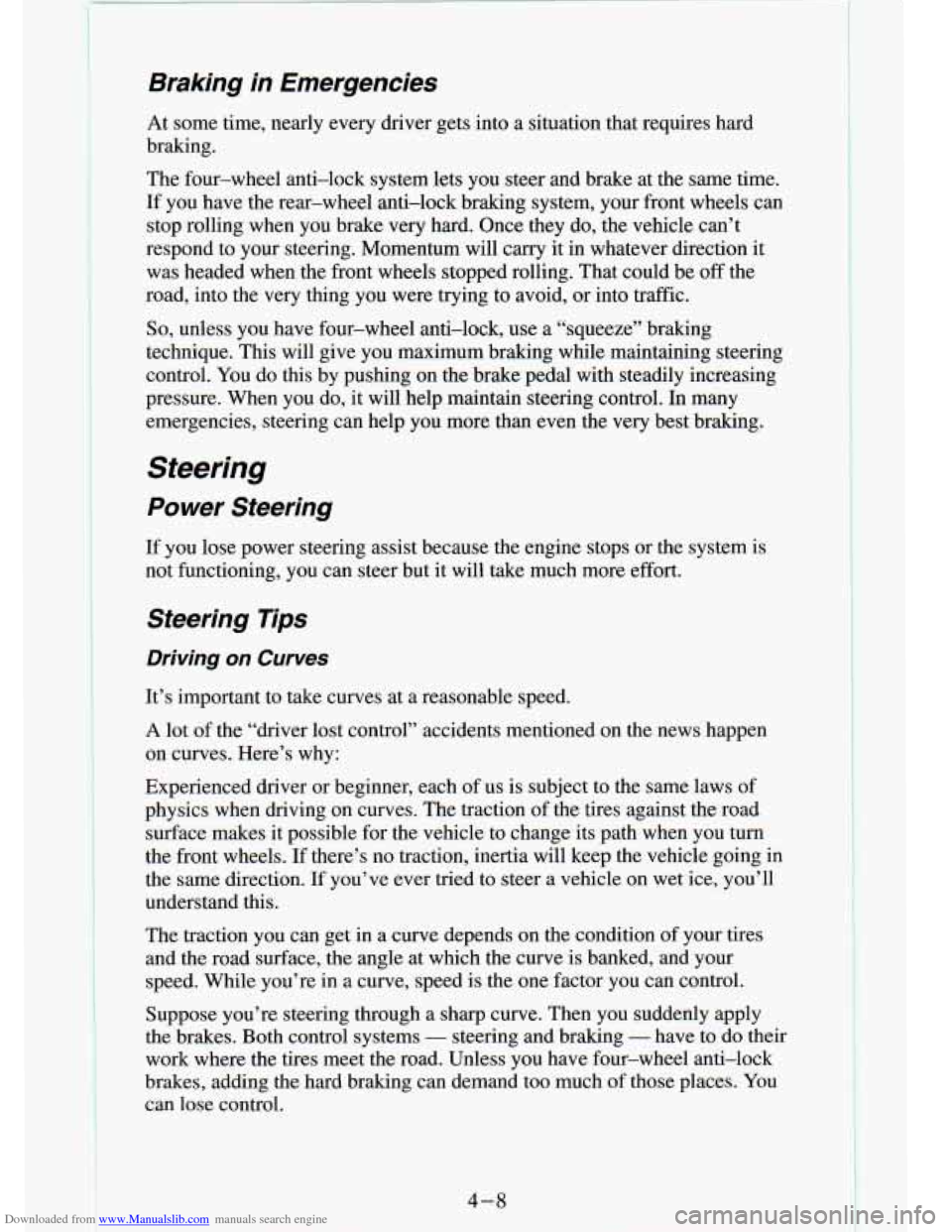
Downloaded from www.Manualslib.com manuals search engine t
Braking in Emergencies
At some time, nearly every driver gets into a situation that \
requires hard
braking.
The four-wheel anti-lock system lets you steer and brake at the same time.
If you have the rear-wheel anti-lock braking system, your front wh\
eels can
stop rolling when you brake very hard. Once they do, the vehicle can’t
respond to your steering. Momentum will carry it in whatever direction it
was headed when the front wheels stopped rolling. That could b\
e off the
road, into the very thing you were trying to avoid, or into traffic.
So, unless you have four-wheel anti-lock, use a “squeeze” braking
technique. This will give you maximum braking while maintaining \
steering
control. You do this by pushing on the brake pedal with steadily increasing
pressure. When you do, it will help maintain steering control. \
In many
emergencies, steering can help you more than even the very best braking.
Steering
Power Steering
If you lose power steering assist because the engine stops or the system is
not functioning, you can steer but it will take much more effort.
Steering Tips
Driving on Curves
It’s important to take eurves at a reasonable speed.
A lot of the “drrver lost control” accidents mentit- ~~- -- - -~ -1-3 news happen
on curves. Here’s why:
bxperienced driver or beginner, each of us is subject to the same laws of
physics when driving on curves. The traction of the tires against the road
surface makes
it possible for the vehicle to change its path when you turn
the front wheels. If there’s no traction, inertia will keep the vehicle going in
the same direction.
If you’ve ever tried to steer a vehicle on wet ice, you’ll
understand this.
The traction you can get in a curve depends on the condition of your tires
and the road surface, the angle at which the curve is banked, and you\
r
speed. While you’re in
a curve, speed is the one factor you can control.
Suppose you’re steering through a sharp curve. Then you suddenly apply
the brakes. Both control systems
- steering and braking - have to do their
work where the tires meet the road. Unless you have four-wheel\
anti-lock
brakes, adding the hard braking can demand too much of those places. You
can lose control.
4 -8
I
Page 154 of 340
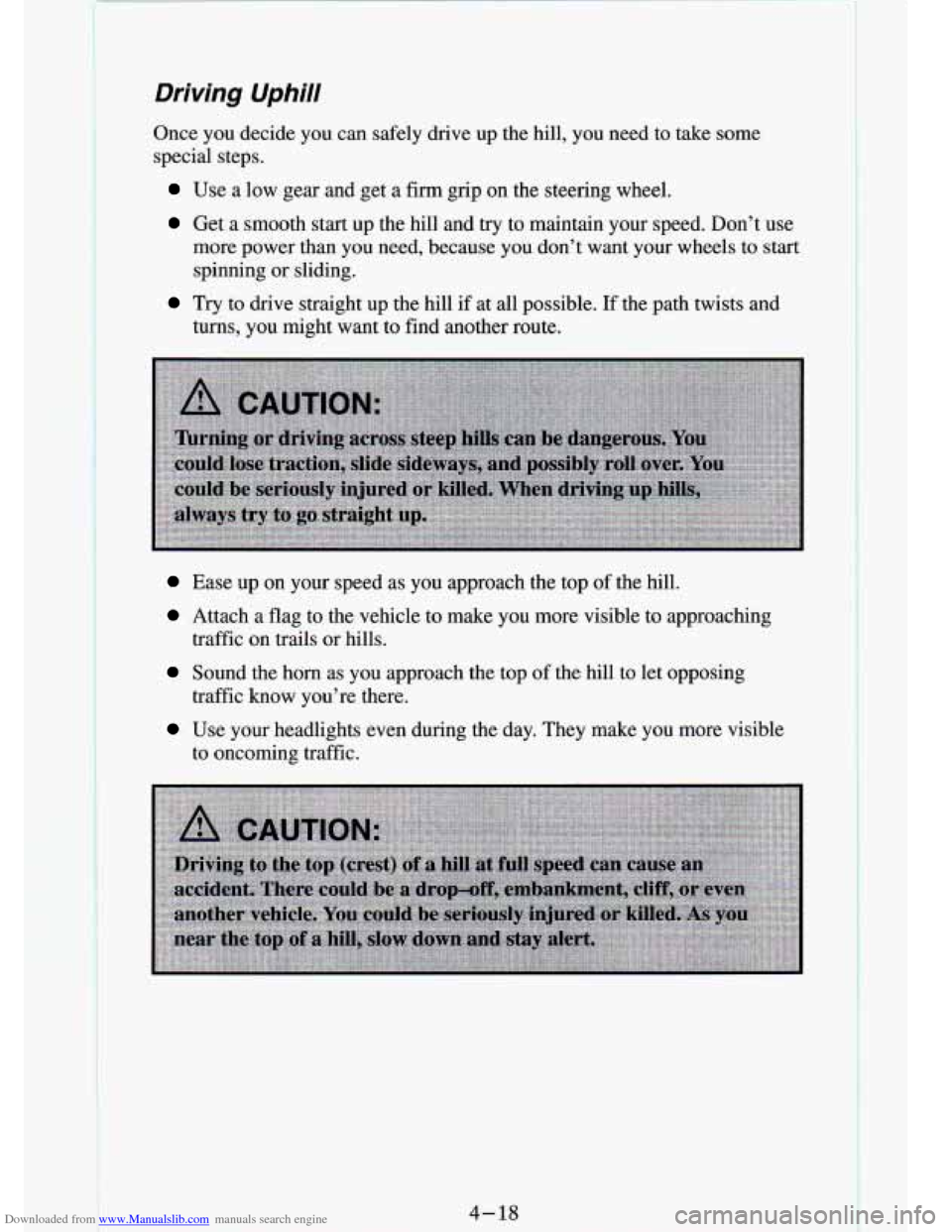
Downloaded from www.Manualslib.com manuals search engine Driving Uphill
Once you decide you can safely drive up the hill, you need t\
o take some
special steps.
Use a low gear and get a firm grip on the steering wheel.
Get a smooth start up the hill and try to maintain your spee\
d. Don’t use
more power than you need, because you don’t want your wheel\
s to start
spinning or sliding.
turns, you might want to find another route.
Try to drive straight up the hill if at all possible. If the path twists and
Ease up on your speed as you approach the top of the hill.
Attach a flag to the vehicle to make you more visible to approaching
Sound the horn as you approach the top of the hill to let opposing
traffic on trails or hills.
traffic know you’re there.
Use your headlights even during the day. They make you more v\
isible
to oncoming traffic.
..
4- 18
Page 219 of 340
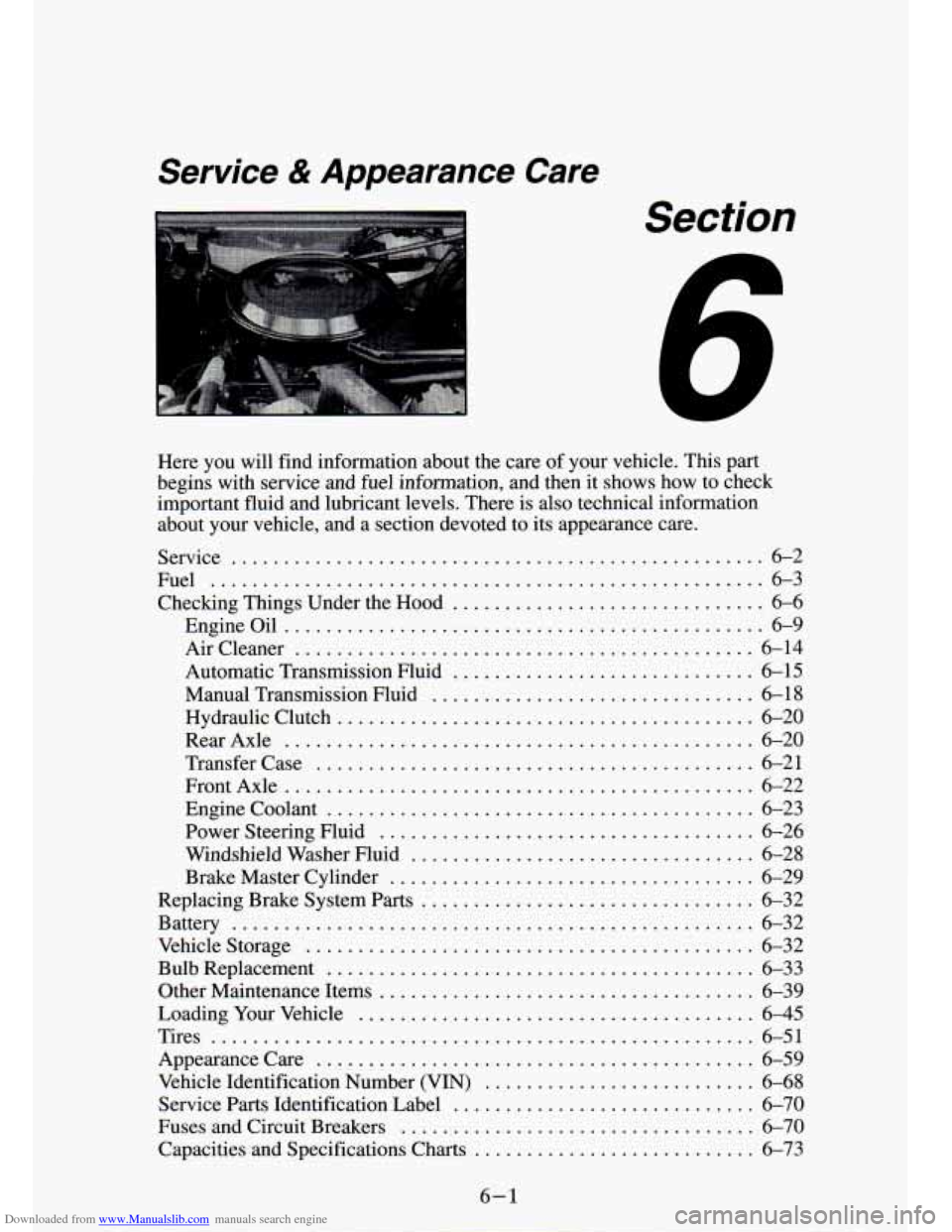
Downloaded from www.Manualslib.com manuals search engine Service & Appearance Care
I
Section
Here you will find information about the care of your vehicle . This part
begins with service and fuel information. and then it shows ho\
w to check important fluid and lubricant levels
. There is also technical information
about your vehicle. and a section devoted to its appearance care
.
Service ................................................... 6-2
Fuel
..................................................... 6-3
Engineoil
.............................................. 6-9
Aircleaner
............................................ 6-14
Automatic Transmission Fluid
............................. 6-15
Manual Transmission Fluid
............................... 6-18
Hydraulic Clutch
........................................ 6-20
RearAxle
............................................. 6-20
Transfer Case
.......................................... 6-21
FrontAxle
............................................. 6-22
Power Steering Fluid
.................................... 6-26
Windshield Washer Fluid
................................. 6-28
Checking Things Under the Hood
.............................. 6-6
Engine Coolant
......................................... 6-23
Brake Master Cylinder
................................... 6-29
Replacing Brake System Parts
................................ 6-32
Bulb Replacement
......................................... 6-33
Battery
.................................................. 6-32
Vehiclestorage
........................................... 6-32
Other Maintenance Items
.................................... 6-39
Loading Your Vehicle
...................................... 6-45
Tires
.................................................... 6-51
Appearancecare
.......................................... 6-59
Vehicle Identification Number (VIN)
.......................... 6-68
Service Parts Identification Label
............................. 6-70
Fuses and Circuit Breakers
.................................. 6-70
Capacities and Specifications Charts
........................... 6-73
6-1
Page 244 of 340
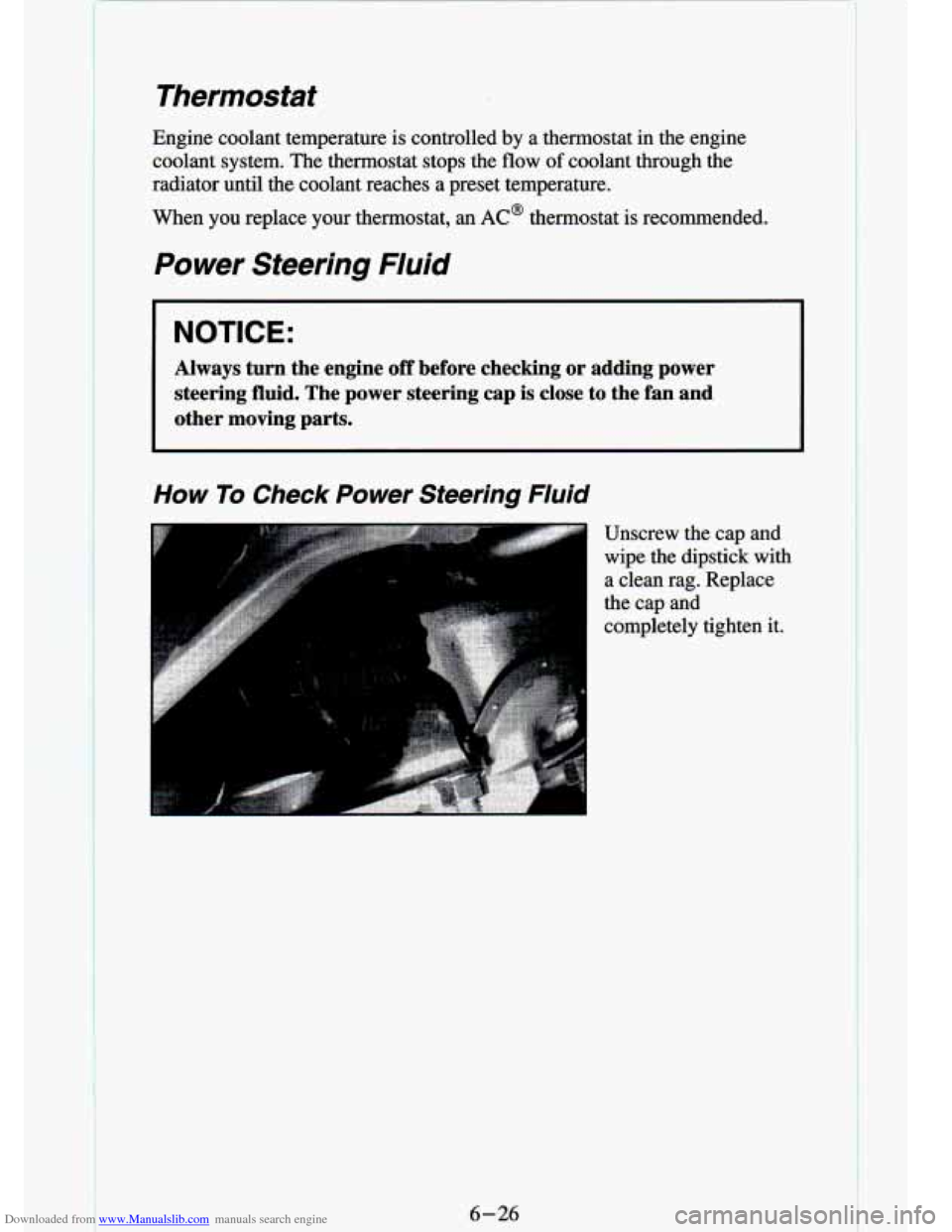
Downloaded from www.Manualslib.com manuals search engine Thermostat
Engine coolant temperature is controlled by a thermostat in the engine
coolant system. The thermostat stops the
flow of coolant through the
radiator
until the coolant reaches a preset temperature.
When you replace your thermostat, an
AC@ thermostat is recommended.
Power Steering Fluid
NOTICE:
Always turn the engine off before checking or adding power
steering fluid. The power steering cap is close
to the fan and
other moving parts.
6-26
Page 245 of 340
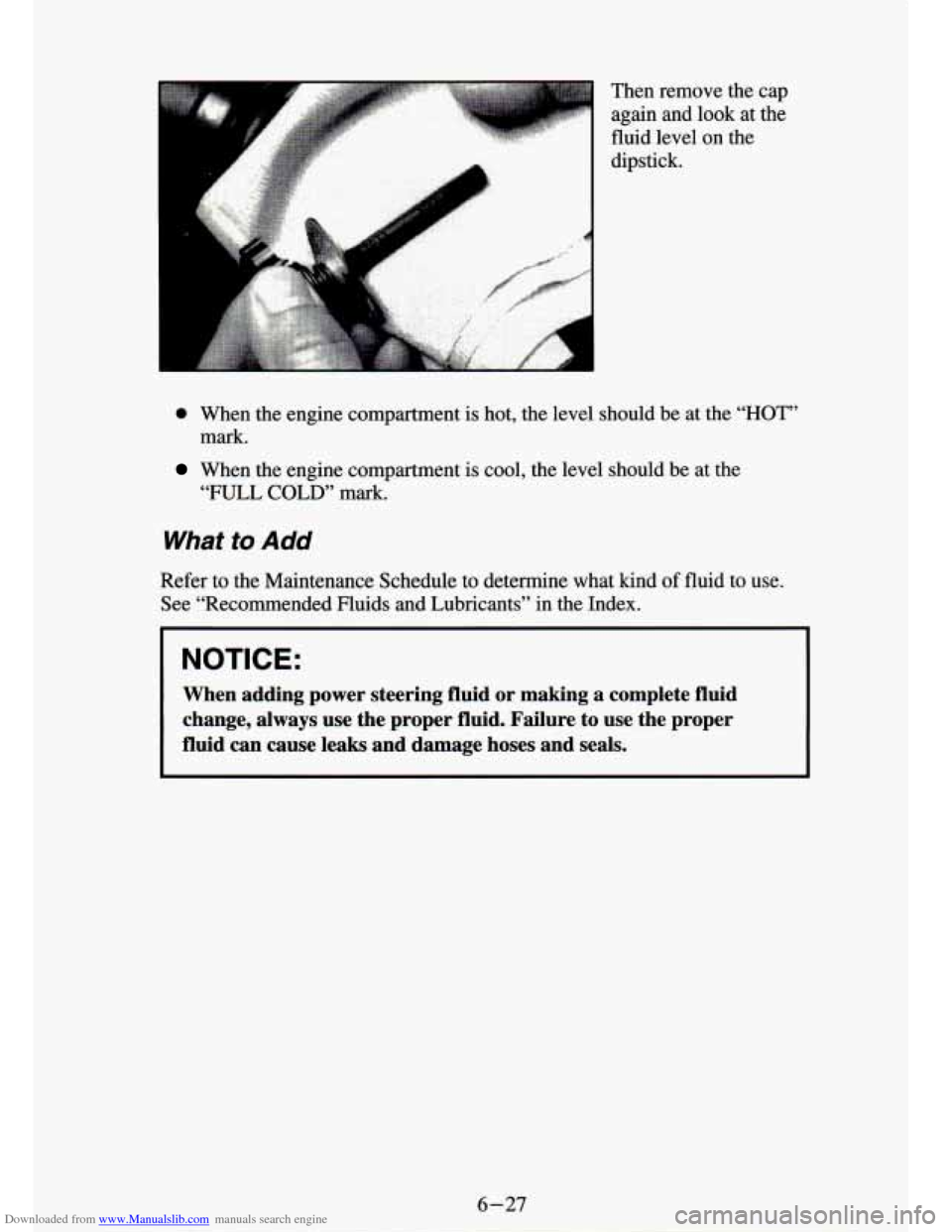
Downloaded from www.Manualslib.com manuals search engine A Then remove the again and look at
fluid level on the
dipstick. cap
the
0 When the engine compartment is hot, the level should be at the “HOT”
mark.
When the engine compartment is cool, the level should be at the
“FULL COLD” mark.
What to Add
Refer to the Maintenance Schedule to determine what kind of fluid to use.
See “Recommended Fluids and Lubricants”
in the Index.
NOTICE:
When adding power steering fluid or making a complete fluid
change, always use the proper fluid. Failure to use the proper\
fluid can cause leaks and damage hoses and seals.
6-27
Page 308 of 340
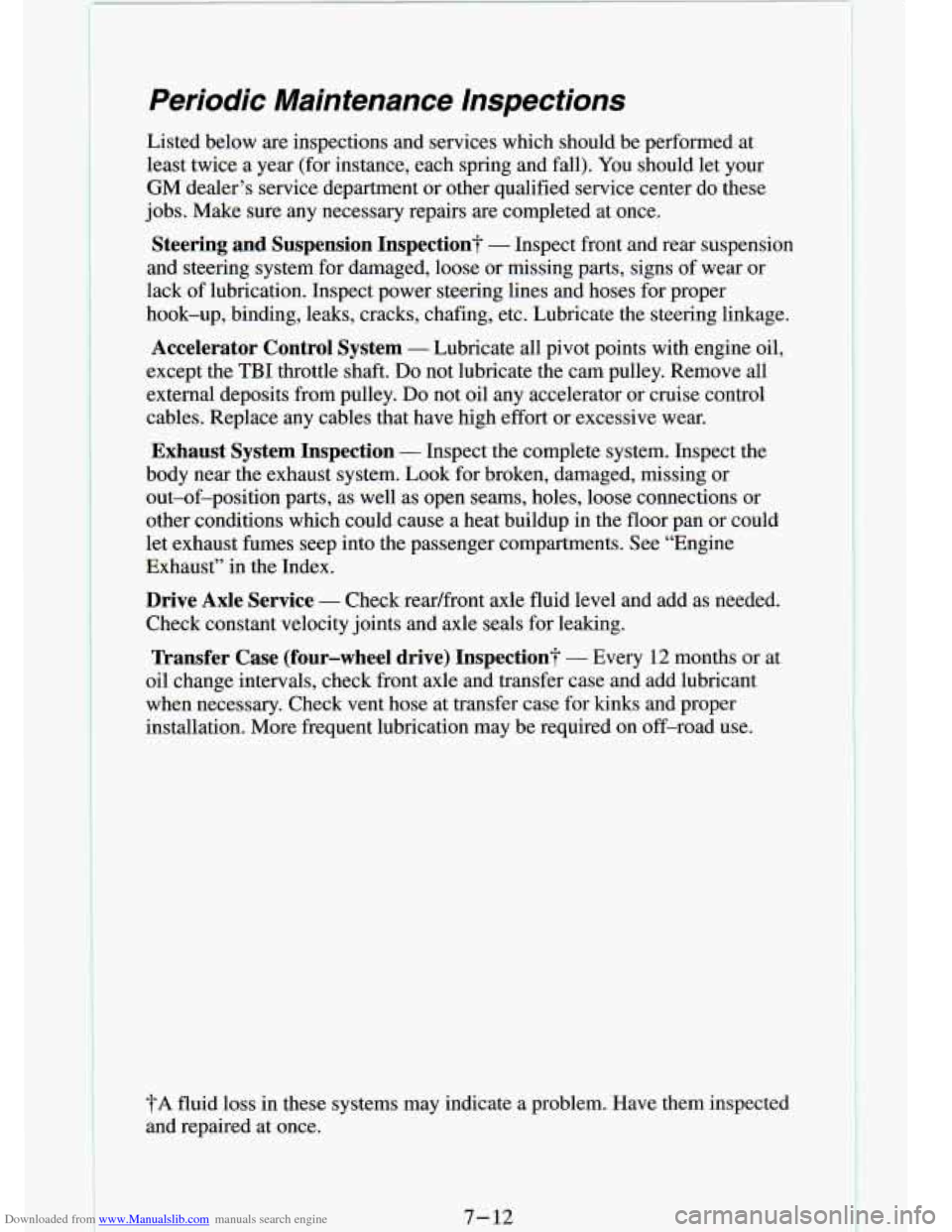
Downloaded from www.Manualslib.com manuals search engine Periodic Maintenance Inspections
Listed below are inspections and services which should be perfo\
rmed at
least twice a year (for instance, each spring and fall). You should let your
GM dealer’s service department or other qualified service center do these
jobs. Make sure any necessary repairs are completed
at once.
Steering and Suspension Inspection? - Inspect front and rear suspension
and steering system for damaged, loose or missing parts, signs of wear or
lack of lubrication. Inspect power steering lines and hoses for proper
hook-up, binding, leaks, cracks, chafing, etc.
Lu‘ ~ kate the steering linkage.
Accelerator Control System - Lubricate all pivot points with engine oil,
except the
TBI throttle shaft. Do not lubricate the cam pulley. Remove all
external deposits from pulley.
Do not oil any accelerator or cruise control
cables. Replace any cables that have high effort or excessive \
wear.
Exhaust System Inspection - Inspect the complete system. Inspect the
body near the exhaust system. Look for broken, damaged, missing
or
out-of-position parts, as well as open seams, holes, loose conn\
ections or
other conditions which could cause a heat buildup in the
floor pan or could
let exhaust fumes seep into the passenger compartments. See “Engine
Exhaust” in the Index.
Drive Axle Service - Check readfront axle fluid level and add as needed.
Check constant velocity joints and axle seals for leaking.
Transfer Case (four-wheel drive) Inspection? - Every 12 months or at
oil change intervals, check front axle and transfer case and add l\
ubricant
when necessary. Check vent hose at transfer case
for kinks and proper
installation. More frequent lubrication may be required on off-road use.
7- 12
?A fluid loss in these systems may indicate a problem. Have them inspected
and repaired at once.
Page 309 of 340
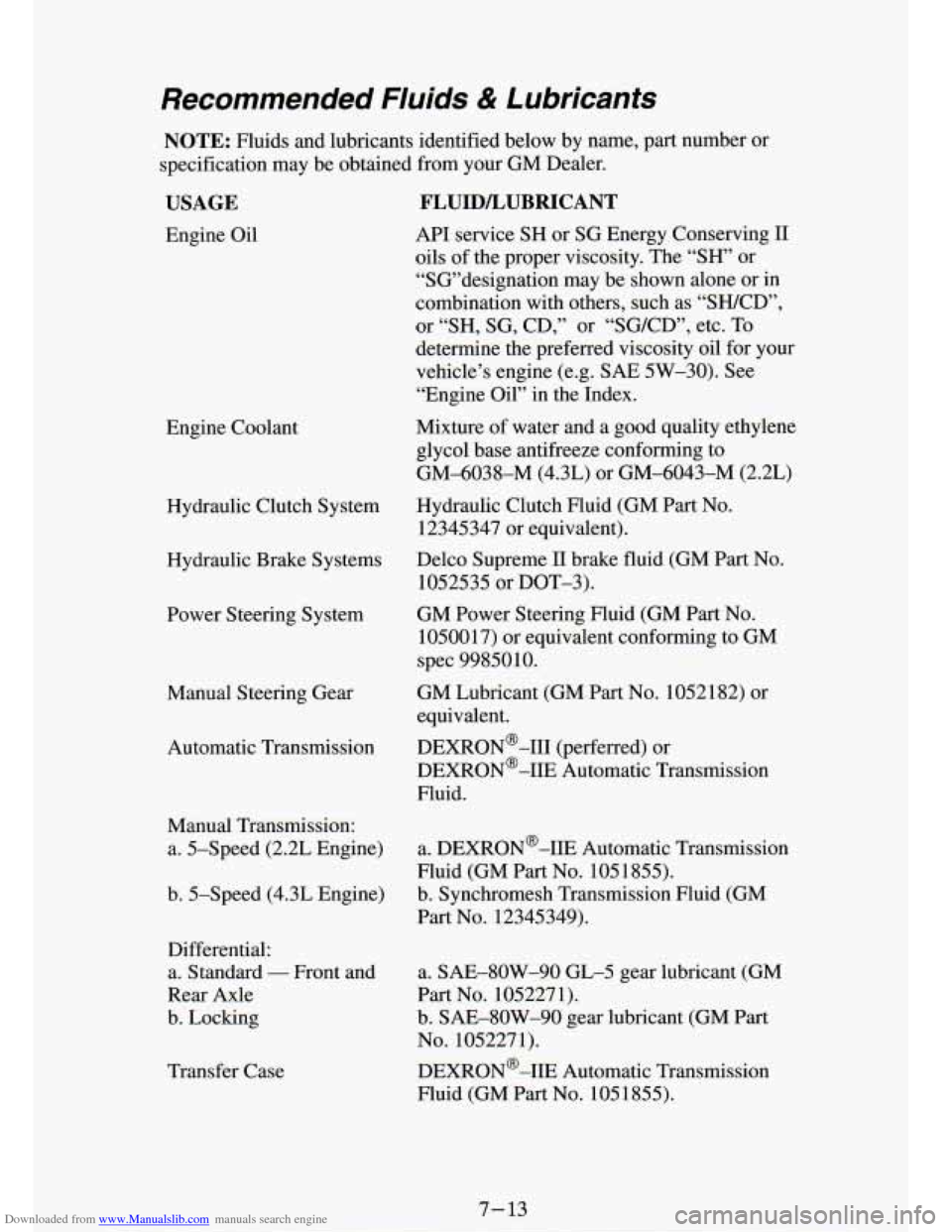
Downloaded from www.Manualslib.com manuals search engine Recommended Fluids & Lubricants
NOTE: Fluids and lubricants identified below by name, part number or
specification may be obtained
from your GM Dealer.
USAGE
Engine Oil
Engine Coolant Hydraulic Clutch System
Hydraulic Brake Systems
Power Steering System
Manual Steering Gear Automatic Transmission
Manual
Iransrmssu
a. 5-Speed (2.2L Engine)
b. 5-Speed (4.3L Engine)
FLUIDLUBRICANT
API service SH or SG Energy Conserving I1
oils of the proper viscosity. The “SH” or
“SG’designation may be shown alone or in
combination with others, such as “SH/CD”,
or “SH, SG, CD,” or “SGKD”, etc. To
determine the preferred viscosity oil for your
vehicle’s engine (e.g. SAE 5W-30). See
“Engine Oil” in the Index.
Mixture of water and a good quality ethylene
glycol base antifreeze conforming to
GM-6038-M (4.3L) or GM-6043-M (2.2L)
Hydraulic Clutch Fluid (GM Part
No.
12345347 or equivalent).
Delco Supreme
11 brake fluid (GM Part No.
1052535 or DOT-3).
GM Power Steering Fluid (GM Part No.
1050017) or equivalent conforming to GM
spec 9985010.
GM Lubricant (GM Part No. 1052182) or
equivalent. DEXRON@-III (perferred) or
DEXRON@-IIE Automatic Transmission
Fluid.
a. DEXRON@-IIE Automatic Transmission
Fluid (GM Part No. 1051855).
b. Synchromesh Transmission Fluid (GM
Part
No. 12345349).
Differential: a. Standard
- Front and a. SAE-8OW-90 GL-5 gear lubricant (GM
Rear Axle Part No. 1052271).
b. Locking b. SAE-SOW-90 gear lubricant (GM Part
No. 1052271).
DEXRON@-IIE Automatic Transmission
Fluid (GM Part No.
1051855).
Transfer Case
7 -23
Page 313 of 340
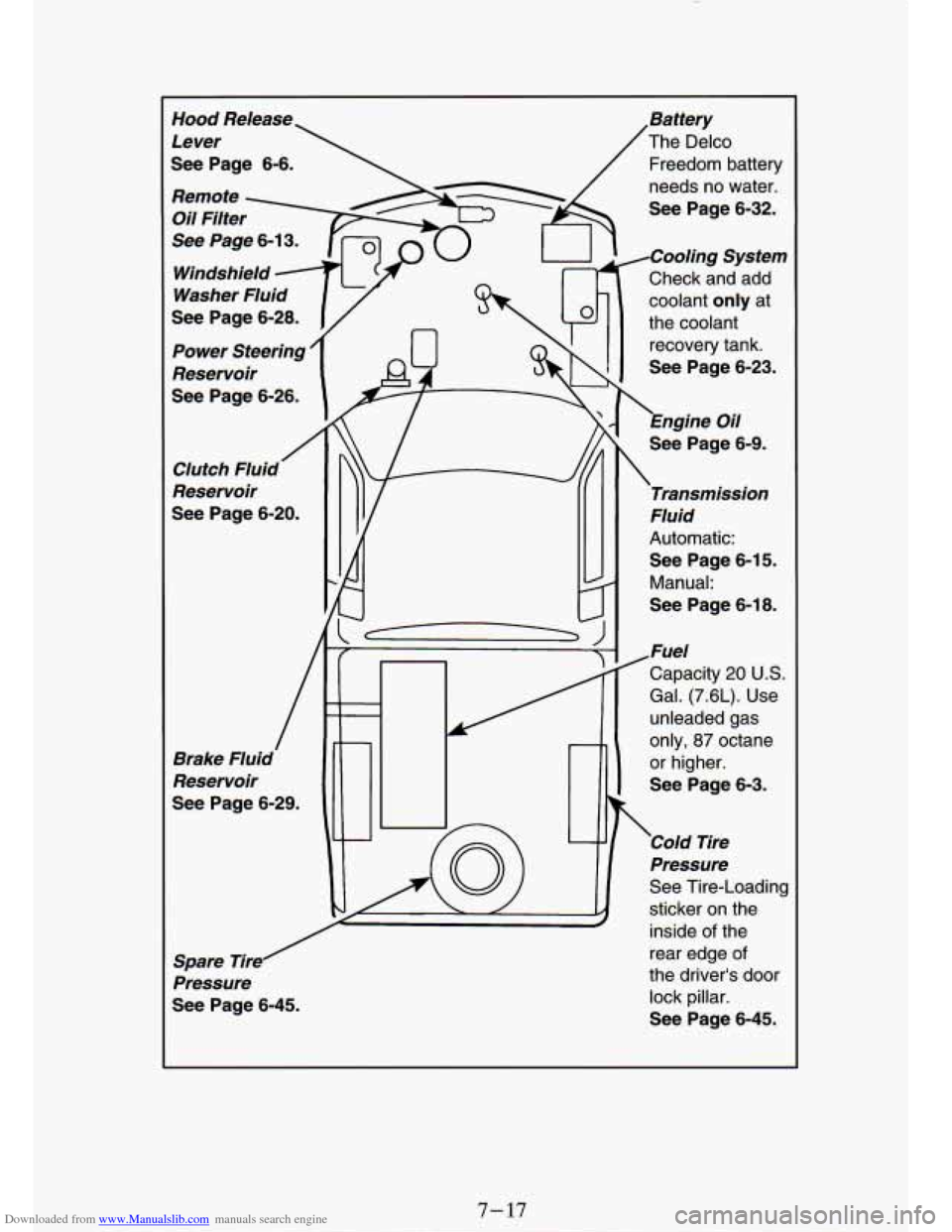
Downloaded from www.Manualslib.com manuals search engine Hood Release
Lever
See Page 6-6.
Remote Oil Filfer
See Page
6-1 3.
Windshield -
Washer Fluid
See Page 6-28.
Power Steering '
Reservoir
See Page 6-26.
,Battery
The Delco
Freedom battery
needs no water.
See Page 6-32. I 4
,Cooling Sysfem
Check and add
coolant
only at
the coolant
recovery tank.
See Page 6-23.
I fit-
Engine Oil
\see Page 6-9m Transmission
Fluid
Automatic:
See Page 6-15.
Manual:
See Page 6-18.
/ Clutch Fluid
Reservoir
See Page 6-20.
I
I c
/
,Fuel
Capacity 20 U.S.
Gal.
(7.6L). Use
unleaded gas
only,
87 octane
or higher.
See Page 6-3.
Brake Fluid.
Reservoir
See Page 6-29.
Cold TiFe
Pressure
See Tire-Loading
sticker
on the
inside
of the
rear edge
of
the driver's door lock pillar.
See Page 6-45.
Spare Tire /
Pressure
See Page 6-45.
7- 17